
HPU2. Nat. Sci. Tech. Vol 03, issue 03 (2024), 80-87.
HPU2 Journal of Sciences:
Natural Sciences and Technology
Journal homepage: https://sj.hpu2.edu.vn
Article type: Research article
Received date: 30-9-2024 ; Revised date: 06-11-2024 ; Accepted date: 14-11-2024
This is licensed under the CC BY-NC 4.0
80
Hybrid affine cipher and eigenvector methods for cryptography
Anh-Thang Le
a
, Thanh-Huyen Pham Thi
a
, Van-Dong Vu
a
*
, Mai-Thanh Hoang Thi
b
,
Bich-Ngoc Nguyen Thi
c
a
Hanoi University of Industry, Hanoi, Vietnam
b
Tuyet Nghia Secondary School, Hanoi, Vietnam
c
Ngoc My Secondary School, Hanoi, Vietnam
Abstract
This paper systematically presents a specific application of linear algebra in information security and
cryptography, highlighting the crucial role of matrix operations and linear techniques in the design and
analysis of encryption algorithms. Specifically, we focus on a method that utilizes linear algebra to
enhance the security and efficiency of modern cryptographic systems. A detailed illustrative example
is provided to help readers better understand how these mathematical tools are applied in practice.
Furthermore, we review existing encryption techniques and propose a new matrix-based scheme that
leverages linear algebra to improve data security, optimize the encryption-decryption process, and
ensure the integrity and confidentiality of information throughout transmission and storage.
Keywords: Information security, encryption, encryption methods, linear algebra applications, affine-
eigenvalue encryption
1. Introduction
Linear algebra plays a crucial role in many areas of life, particularly in economics and
engineering. In economics, optimization models, data analysis, and forecasting rely on linear algebra
methods to efficiently process and analyze large volumes of data (see e.g. [1]–[3]). In the field of
engineering, linear algebra serves as the foundation for applications such as signal processing, solving
differential equations, and automatic control systems (see e.g. [4]–[6]). Additionally, in computer
science, linear algebra supports the development of algorithms and data encryption, thereby ensuring
information security within network systems (see e.g. [7]). With its diverse and extensive applications,
*
Corresponding author, E-mail: dongvv@haui.edu.vn
https://doi.org/10.56764/hpu2.jos.2024.3.3.80-87

HPU2. Nat. Sci. Tech. 2024, 3(3), 80-87
https://sj.hpu2.edu.vn 81
linear algebra is not only a powerful tool for scientists but also a bridge between mathematics and
practice.
In the field of information encryption, linear algebra plays a key role in designing security
algorithms, such as Rivest-Shamir-Adleman (RSA) public key encryption, matrix-based
cryptosystems, and the Advanced Encryption Standard (AES) (see e.g. [8]). Linear transformations
and matrix algebra facilitate the construction of robust encryption systems; thereby protecting
information from unauthorized access and ensuring data integrity during transmission (see e.g. [9]).
Specifically, techniques such as eigenvalue decomposition and singular value decomposition are
employed to tackle complex encryption problems, optimizing the process of encrypting and decrypting
information (see e.g. [10]). These applications highlight the significance of linear algebra in creating
secure and efficient encryption systems that meet the growing demands for information security in the
digital age. This paper aims to present some applications of linear algebra in the field of information
security and cryptography, thereby clarifying the important role of matrix operations and linear
techniques in the construction and analysis of encryption algorithms. Specifically, the paper will focus
on methods that utilize linear algebra to enhance the safety and efficiency of modern encryption
systems, while also providing illustrative examples and real-world case studies to help readers gain a
better understanding of how these mathematical tools are applied in practice.
The remainder of the paper is organized as follows: The next section presents some linear algebra
knowledge used to develop efficient encryption algorithms, aiding in the optimization of information
security processes. The third section will provide a brief overview of several well-known encryption
techniques in practice. In the fourth section, we propose a matrix-based encryption program that
applies linear algebra techniques to improve the security and efficiency of the system. Finally, the last
section will provide some conclusions and future research prospects.
2. Some fundamentals of linear algebra
This section presents some fundamental concepts of linear algebra, derived from sources such as
[11], [12], and [13], that are useful in the development and analysis of encryption algorithms.
Definition 2.1 (Matrix). An
m n
matrix is a rectangular array of real numbers, arranged in
m
rows and
n
columns. The elements of a matrix are called the entries. The expression
m n
denotes
the size of the matrix.
A general
m n
matrix A has the form
11 12 1
21 22 2
1 2
n
n
m m mn
a a a
a a a
A
a a a
,
where each matrix element ij
a
. If
m n
the matrix is said to be square.
Definition 2.2 (Matrix addition and scalar multiplication). If
A
and
B
are two
m n
matrices,
then the sum of the matrices
A B
is the
m n
matrix with the
ij
term given by
ij ij
a b
. The scalar
product of the matrix
A
with the real number
c
, denoted by
cA
, is the
m n
matrix with the
ij
term
given by
ij
ca
.

HPU2. Nat. Sci. Tech. 2024, 3(3), 80-87
https://sj.hpu2.edu.vn 82
Definition 2.3 (Matrix multiplication). Let
A
be an
m n
matrix and
B
be an
n p
matrix;
then the product
AB
is an
m p
matrix. The
ij
term of
AB
is the dot product of the
i
th row vector
of
A
with the
j
th column vector of
B
, so that
1 1 2 2
1
.
( )
p
ij ik kj i j i j ip pj
k
a b a b a bAB
a b
(1)
Definition 2.4 (Minors and cofactors of a matrix). If
A
is a square matrix, then the minor
ij
M
,
associated with the entry
ij
a
, is the determinant of the
( 1) ( 1)
n n
matrix obtained by deleting row
i
and column
j
from the matrix
A
. The cofactor of
ij
a
is ( 1)i j
ij ij
C M
.
Definition 2.5 (Determinant of a square matrix). Let
A
be an
n n
matrix, The determinant of
the matrix
A
, denoted as
det( )
A
, is defined by
11 11 12 12 1 1 1 1
1
d· ·et ·( )
n
n n k k
k
A a C a C a C a C
(2)
Definition 2.6 (Inverse of a square matrix). Let
A
be an
n n
matrix. If there exists an
n n
matrix
B
such that
AB I BA
then the matrix
B
is a (multiplicative) inverse of the matrix
A
, and
it is denoted by
1
A
.
Theorem 2.1. Let
A
be an invertible
n n
matrix. Then
11 21 1
12 22 2
1
1 2
1 1
det( ) det(
ad )
j
n
n
n n nn
c c c
c c c
A A
A A
c c c
. (3)
where
( 1) det( )
i j
ij ij
c M
.
Definition 2.7 (Eigenvalue and eigenvector). Let
A
be an
n n
matrix. A number
is called an
eigenvalue of
A
provided that there exists a nonzero vector
v
in
n
such that
Av v
.
Every nonzero vector satisfying this equation is called an eigenvector of
A
corresponding to the
eigenvalue
.
Definition 2.8 (Null space of mattrix). The null space of a matrix
A
, denoted as
Null( )
A
, is the
set of all vectors
x
such that:
0
Ax
.
Let’s summarize the procedure to find the eigenvalues and eigenvectors (eigenspaces) of a matrix
A
, where
A
is an
n n
matrix.
Compute the characteristic polynomial
det
A I
of
A
.
Find the eigenvalues of
A
by solving the characteristic equation
det 0
A I
for
.
For each eigenvalue
, find the null space of the matrix
A I
. This is the eigenspace
E
,
the nonzero vectors of which are the eigenvectors of
A
corresponding to
.
Find a basis for each eigenspace.

HPU2. Nat. Sci. Tech. 2024, 3(3), 80-87
https://sj.hpu2.edu.vn 83
3. Some encryption techniques
To encrypt or decrypt a message, we need to assign a number to each letter in the alphabet. The
easiest way to do this is to associate 0 with a blank or space, 1 with A, 2 with B, and so on.
0 = , 1 = A, 2 = B, 3 = C, 4 = D, 5 = E, 6 = F, 7 = G, 8 = H, 9 = I,
10 = J, 11 = K, 12 = L, 13 = M, 14 = N, 15 = O, 16 = P, 17 = Q, 18 = R,
19 = S, 20 = T, 21 = U, 22 = V, 23 = W, 24 = X, 25 = Y, 26 = Z.
Another way is to associate 0 to a blank or space, 1 to A, -1 to B, 2 to C, -2 to D, and so on.
3.1. Hill cipher
Hill cipher is a matrix encryption method invented by Lester S. Hill in 1929 (see [14]). It is one of
the first block cipher systems to use linear algebra. Since then, many authors have utilized this
technique, for example, in [15] and [16].
Idea: The original information (in vector form) can be encrypted by multiplying it with a key
matrix. Specifically, a message can be represented as a vector, and encryption is achieved by
multiplying this vector with an invertible key matrix.
Encryption process:
Use a square matrix
K
of size
n n
as the encryption key.
The original text string is divided into character blocks of length
n
. Each block is represented
as a column vector.
Encrypt each block by multiplying the key matrix with the character vector:
C MK
, where
M
is the original text vector and
C
is the encrypted vector.
Decryption process:
Calculate the inverse matrix
1
K
of the key matrix.
Decrypt each block by multiplying the inverse matrix with the encrypted vector:
1
M CK
.
Note: The matrix
K
must have a non-zero determinant and an inverse matrix
1
K
must exist.
3.2. Affine cipher
Idea: Use an affine encryption method based on linear algebra, where a message is transformed
by a linear function and a constant (matrix) is added (see, for example [17]–[19]).
Encryption process:
Use two matrices
A
and
B
, with
A
being a non-degenerate square matrix (having a non-zero
determinant).
Encrypt each character using the linear transformation:
C MA B
.
Decryption process:
Calculate the inverse matrix
1
A
.
Decrypt by applying the inverse transformation:
1
M C B A
.
Note:
A
must have an inverse.
3.3. Based quadratic form encryption
This technique uses the encoding matrix as the diagonalized matrix of a given quadratic form (see
[20]. For example, if the quadratic form is given by
2 2 2
1 2 3 1 2 3 1 2 1 3
, , 6 5 7 4 4
Q x x x x x x x x x x

HPU2. Nat. Sci. Tech. 2024, 3(3), 80-87
https://sj.hpu2.edu.vn 84
then the matrix of this quadratic form
6 2 2
250
2 0 7
.
Also the canonical form is
2 2 2
1 2 3
3 6 9
y y y
whose matrix is given by
300
0 6 0
0 0 9
E
.
We have the encoder as
E
. Then the message matrix is converted into a new matrix X (encoded
matrix) using matrix multiplication as
X ME
, where
M
is a message matrix. Then this is sent to
the receiver. Then the receiver decode this matrix with the help of a matrix D (decoder matrix) which
is nothing but the inverse of the encoder (i.e.,
1
D E
), to get the message matrix back as
1
.
M XE
The encryption methods presented in this section offer several notable advantages. The Hill
cipher processes data in blocks, providing better security compared to single-character encryption
methods, while also being easy to implement with basic matrix operations. The affine cipher can be
extended to various applications due to its linear nature. The method based on quadratic forms
enhances security and offers flexibility in specific applications.
4. Affine cipher and eigenvectors-based encryption
The methods presented in the previous section also have drawbacks: Hill cipher and affine cipher
are vulnerable to attacks if the original and encrypted pairs are exposed, and they are not strong
enough for modern applications. The method based on quadratic forms is more complex, requiring
extensive computation and careful key selection to avoid exploitation. Building on the eigenvectors of
the matrix and the affine cipher technique, we propose the following encryption and decryption
method:
Encryption process:
Let
A
and
B
be two matrices.
Find the eigenvalues and the corresponding eigenvectors of the matrix
A
. Construct the
matrix
P
whose columns are the eigenvectors of
A
.
Encrypt the message
M
using the formula 1
C P MP B
.
Decryption process
Decrypt by applying the inverse transformation:
1
M P C B P
.
Note that the matrix
A
is chosen such that the matrix
P
is invertible, and
B
is any matrix that
satisfies the additive condition with matrix
A
.
Example
Consider the message to be sent: GOOD LUCK.
We take the standard codes as follows: 0 → Space, 1 → A, 2 → B, ... 26 → Z;
We convert the above message into a stream of numerical values as follows
G
O
O
D
L
U
C
K
7
15
15
4
0
12
21
3
11

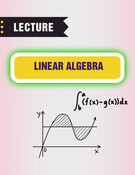


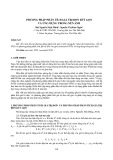
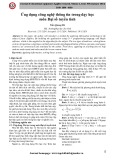
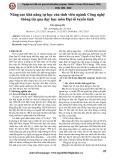
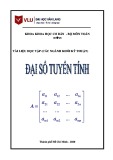

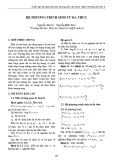
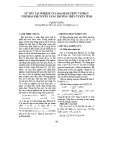










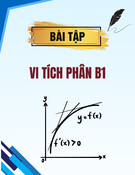



![Quyển ghi Xác suất và Thống kê [chuẩn nhất]](https://cdn.tailieu.vn/images/document/thumbnail/2025/20251030/anh26012006/135x160/68811762164229.jpg)
